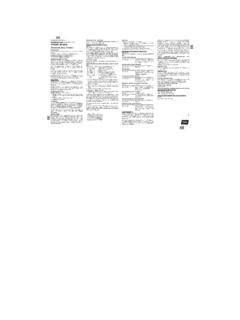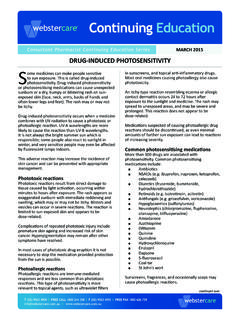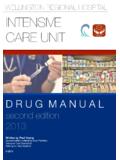Transcription of COXFLAM 7.5 (Tablets) Side-effects and Special Precautions ...
1 Scheduling Status: S3 Once daily dosing leads to drug plasma intestinal toxicity in children and should therefore not meal. Noticeable improvement in severe conditions Concomitant administration of other potentially are decreased, it may precipitate overt renal Interactions: Known Symptoms of Overdosage and concentrations with relatively small peak-trough fluc- be prescribed to children under the age of 15 years. may require 1 to 2 weeks of continuous use. myelotoxic drugs, in particular methotrexate, can be a decompensation which is typically followed by An increased risk of gastro-intestinal ulceration and Particulars of its Treatment: Proprietary Name (and dosage form): tuations. Safety during pregnancy and lactation has not been predisposing factor for the onset of cytopenia. recovery to pre-treatment state upon discontinuation bleeding may occur with the concurrent administration See Side-effects and Special Precautions .
2 Side-effects and Special Precautions : COXFLAM ( tablets ) The major metabolic transformation in humans, is the established (see Warnings ). side -effects: Cardiovascular: Oedema has more frequently been of treatment in these patients. Patients at risk of such of two or more NSAID's (including aspirin), due to the Treatment is symptomatic and supportive. oxidation of the methyl group on the thiazolyl ring of reported and less frequently, palpitations, flushes and a reaction include dehydrated patients, those with synergistic action produced. Standard measures of gastric evacuation should be COXFLAM 15 ( tablets ) the active ingredient. The inactive metabolites are Warnings: Gastro-intestinal symptoms are the most common increased blood pressure. congestive heart failure, liver cirrhosis, nephrotic The concomitant use of corticosteroids may increase used in alert patients. Regular use of NSAIDs during the third trimester of Side-effects encountered.
3 Composition: excreted in the urine and in the faeces (about half in Respiratory: The onset of acute asthma has been syndrome and overt renal disease, those on diuretic the incidence of upper gastro-intestinal toxicity. Clinical trials have shown that cholestyramine pregnancy may result in premature closure of the foetal NSAIDs may increase the incidence of bleeding Each COXFLAM tablet contains mg each). reported in some patients following the administration therapy or those having undergone major surgical The effects of oral anticoagulants, such as coumarin, accelerates the elimination of meloxicam. ductus arteriosus in utero and possibly in persistent in the upper gastro-intestinal tract and of perforation. meloxicam (4-hydroxy-2-methyl-N-(5-methyl- Less than 5% of meloxicam is excreted unchanged in of meloxicam. procedures, which have led to hypovolaemia. In such indandion derivates or heparin, may be enhanced. Identification: pulmonary hypertension of the newborn.))
4 The onset of The most important patient-related risk factors for 2-thiazolyl)-2H-1, 2-benzothiazine-3-carboxamide 1, the faeces, with only small amounts unchanged in the Hypersensitivity reactions may occur occasionally patients the extent of diuresis and the renal function Meloxicam is bound in the gastro-intestinal tract by COXFLAM : A yellow coloured, circular, flat, labour may be delayed and its duration increased. upper gastro-intestinal toxicity are old age, a history 1-dioxide). urine. and may include fever, angioedema, bronchospasm should be monitored when therapy is initiated. cholestyramine, and this leads to a faster elimination bevelled, uncoated tablet, with a central break-line on ( tablets ) The medication should be stopped and emergency of peptic ulcers or bleeding of the gastro-intestinal The mean elimination half life of meloxicam is 20 hours. and rashes. Less frequently hepatotoxicity and In rare instances NSAID's may cause interstitial of meloxicam.
5 One side and plain on the other. COXFLAM 15 Each COXFLAM 15 tablet contains 15 mg meloxicam treatment obtained if the following occurs: anaphylaxis, tract and the concomitant use of corticosteroids. The pharmacokinetics of meloxicam is not adversely aseptic meningitis may occur, which may also be nephritis, glomerulonephritis, papillary necrosis and Increased plasma concentrations of lithium, COXFLAM 15 : A yellow coloured, circular, flat, (4-hydroxy-2-methyl-N-(5-methyl-2-thiazo lyl)-2H-1, angioedema or bronchospasm. The medication should The following Side-effects have been reported: affected by mild or moderate renal and hepatic hypersensitivity reactions. the nephrotic syndrome. methotrexate and cardiac glycosides may be present. bevelled, uncoated tablet, with a central break-line on ( tablets ) 2-benzothiazine-3-carboxamide 1,1-dioxide). be stopped and a physician consulted if the following Gastro-intestinal /hepatobiliary: Abdominal pain, insufficiency.
6 Plasma clearance occurs at approxi- Other less frequent adverse effects that occur with COXFLAM should be used with caution in patients The plasma levels of these medicines should be one side and 15' embossed on the other side . Pharmacological Classification: occurs: unexplained nosebleed, chest pain, spitting nausea and vomiting, constipation or diarrhoea, COXFLAM mately 8 ml/minute and is halved in the elderly. the use of non-steroidal anti-inflammatory agents may with infections since meloxicam may mask symptoms carefully monitored. A Anti-rheumatics (anti-inflammatory agents). of blood, convulsions, fainting, gastrointestinal dyspepsia and flatulence have more frequently been Presentation: include alveolitis, pulmonary oesinophilia, and toxic like fever and inflammation. The hematologic toxicity of methotrexate may be Indications: bleeding or ulceration and blood dyscrasias. reported. Oesophagitis, eructation, gastro-duodenal COXFLAM : Aluminium strips of 10 tablets packed Pharmacological Action: epidermal necrolysis.
7 The risk benefit should be considered in patients with increased. Strict monitoring of the blood cell count is For the symptomatic relief of painful and/or ulcer, and gastro-intestinal bleeding (occult or in 10's, 30's or 100's. Meloxicam is a non-steroidal anti-inflammatory drug Dosage and Directions for Use: mild allergic reactions, such as urticaria, skin rash therefore advised. inflammatory conditions, including musculoskeletal macrosopic) and abnormalities of liver function Special Precautions : (NSAID) with analgesic, anti-inflammatory and Adults: and allergic rhinitis, induced by aspirin or other Acute renal insufficiency may occur in patients who COXFLAM 15 : Aluminium strips of 10 tablets packed and joint disorders such as osteoarthritis, parameters ( raised bilirubin or transaminases), Side-effects such as gastrointestinal ulceration and antipyretic properties. It is one of the oxicam Rheumatoid arthritis: 15 mg meloxicam once daily.
8 NSAID's. The risk benefit should also be considered are dehydrated. Patients who receive concurrent in 10's, 20's, 30's or 50's. rheumatoid arthritis and ankylosing spondylitis. have less frequently been reported. The induction or bleeding, are more likely to occur in the elderly, and derivatives, a member of the enolic acids. The dose may be reduced to mg daily according are more likely to be of a serious nature, although they in patients suffering from inflammatory or ulcerative diuretics should be adequately hydrated and their renal Storage Instructions: Contra-Indications: exacerbation of colitis, gastrointestinal perforation and function carefully monitored. The action of meloxicam is due to its selective to the therapeutic response. may occur at any time during treatment with or without diseases of the gastro-intestinal tract. Store in well closed containers, below 25 C. Known hypersensitivity to meloxicam, any other hepatitis have occasionally been reported.
9 There may be an increased risk of nephrotoxicity when inhibiting effect on the enzyme cyclo-oxygenase-2 Osteo-arthritis: mg meloxicam once daily. warning symptoms or a previous history of serious Patients suffering from bleeding problems KEEP OUT OF REACH OF CHILDREN. (COX-2) relative to cyclo-oxygenase-1 (COX-1), non-steroidal anti-inflammatory drugs (NSAIDs) or Neuropsychiatric: Dizziness, headache, tinnitus and (coagulation or platelet function disorders) or hae- administered concomitantly with angiotensin convert- In severe cases: 15 mg meloxicam once daily. gastro-intestinal events. Patients with a history of Registration Numbers: which are involved in the biosynthesis of prostaglandins. to aspirin. The potential for cross sensitivity to aspirin drowsiness have been reported as well as nervous- mophilia should be carefully monitored and the asso- ing enzyme inhibitors, cyclosporine and diuretics. Ankylosing upper GIT disease and patients on anticoagulants COXFLAM : 35 Prostaglandins play an important role in the mediation and other NSAIDs exists.
10 Ness, depression, insomnia, hearing loss, visual ciated risk considered. An increased risk of hyperkalaemia may be present spondylitis: 15 mg once daily. should be treated with caution. Those with upper GIT COXFLAM 15: 35 of inflammation, pain and fever. Meloxicam should not be administered to patients with disturbances and vertigo. In view of the product's inherent potential to cause with angiotensin converting enzyme inhibitors, and symptoms should be monitored and COXFLAM . COXFLAM Adverse gastro-intestinal and renal effects are a history of allergic reactions (such as skin rashes, Elderly and other Dermatological: Urticaria, pruritus and skin rashes fluid and electrolyte retention and its interference with potassium-sparing diuretics. Name of Business and Address of Applicant: treatment should be stopped if peptic ulceration or urticaria, rhinitis, asthma, angioedema and anaphy- patients with may occur and less frequently stomatitis.)









